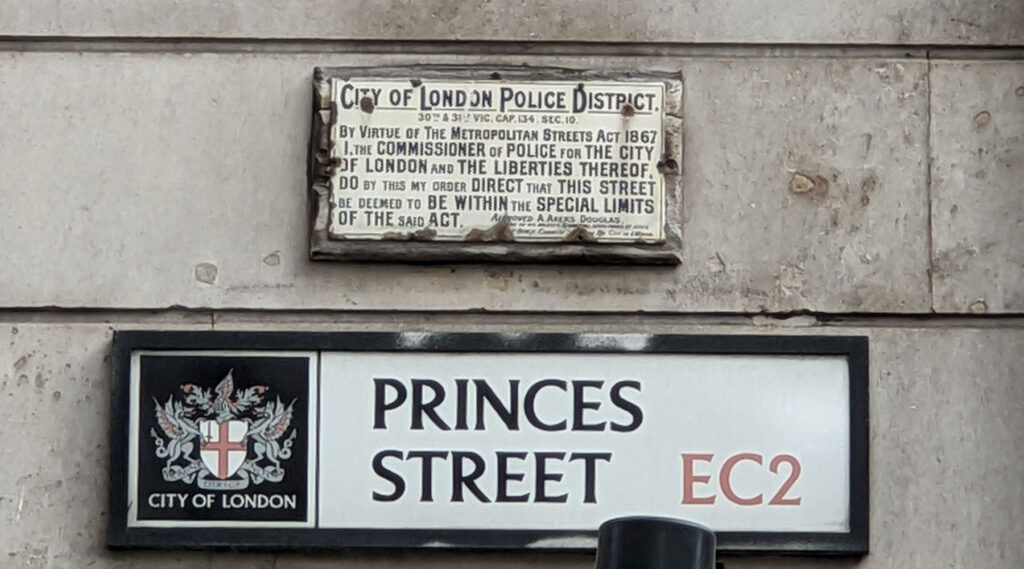If you look up on the wall on the side of the Bank of England building, you might see a very old sign declaring that this street is within special limits.
What the sign says is: “By virtue of the Metropolitan Streets Act 1867 I, the commissioner of police for the City of London and the Liberties Thereof, do by this my order direct that this street be deemed to be within the special limits of the said act”
What does it mean, and is it still valid?
The Metropolitan Streets Act 1867 came into effect on 1st November 1867 and tidied up a lot of mess about how streets were to be used, or not used as the case may be, and was an early form of “highway code”. However, it proved to be very unpopular as traders felt it overly restricted their activities — such as limits on driving cattle through the streets and loading or unloading of wagons.
Its range was the 4-mile radius around Charing Cross and was basically an attempt to make the streets safer for pedestrians by restricting the behaviour of delivery wagons and vehicles. Most of the area was covered by the General Limits, but the police had the ability to declare streets to be subject to Special Limits, which added further restrictions.
It covered issues such as limits on delivery wagons not being allowed to loiter while delivering goods beyond a reasonable time, that stagecoaches could only stop on the left side of a road, limits on adverts carried on vehicles, and even down to issues covering dog control.
However, just a few weeks after it came into effect, the police decided to declare a large number of streets as subject to the Act’s special limits.
The London Gazette of 27th December 1867 published the formal notice – copies at the end of the article, authorising the change – not just to this road, but to loads of streets in the City.
Within these limits, coal could not be unloaded on footpaths, nor machinery or ropes set up to unload casks across such footpaths between 10am and 6pm other than for wine and spirit casks, whilst carts with more than four horses between 10am and 7pm. The police also restricted the number of places that early omnibuses were allowed to stop for passengers.
There were even restrictions on how the maximum length a ladder could be if carried through the streets during the daytime. Thirty-five feet in case you were wondering.
The act is no longer in effect, having been superseded by many other laws, but here, on the side of the Bank of England, they’re still displaying that 155 year old sign warning that the street is subject to special limits, even though they’re not.
The text of the order:
The following Order, made by the Commissioner of the Police Force of the City of London and the Liberties thereof, directing that the streets and portions of .streets therein mentioned within the ” General Limits” of the Metropolitan Streets Act, 1867, are to be deemed to be witbin the ” Special Limits” of the Act, has received the approval of the Secretary of State.
CITY OF LONDON POLICE DISTRICT.
By virtue of the “Metropolitan Streets Act, 1867,” I, the Commissioner of Police of the City of London and the Liberties thereof, do by this my order; direct that the undermentioned streets and portions of streets, within the general limits of the said Act, are to be deemed to be. within the special limits of the said Act. Aldgate, Bishopsgate-street Within, Cannon-street, Chancery-lane, Cheapside, Cornhill, Fenchurch-street, Fleet-street, Gracechurch-street, Gresham-street, Holborn-hill, King-street, Cheapside, King-street, Snow-hill, King William-street, Leadenhall-street, Lombard-street, London Bridge, Lothbury, Ludgate-hill, Mansion-House-street, Moorgate-street, New Bridge-street, New Broad-street, Newgate-street, Old Broad-street, Old Jewry, Poultry, Princes-street, Queen’s-street, Skinner-street, St. Paul’s-churchyard (south side), Snow-hill, Threadneedle-street, Throgmorton-street.
Witness my hand this 1st day of November, 1867.
(Signed) JAMES FRASER, Colonel.
Approved— (Signed) GATHORNE HARDY.
Whitehall, December 20, 1867









Very interesting, now, how about ‘carters marks’ are they still valid and do modern vehicles have a similar system?
The Bank still mounted an armed guard using British Army soldiers, called the picket, until I think 1977.